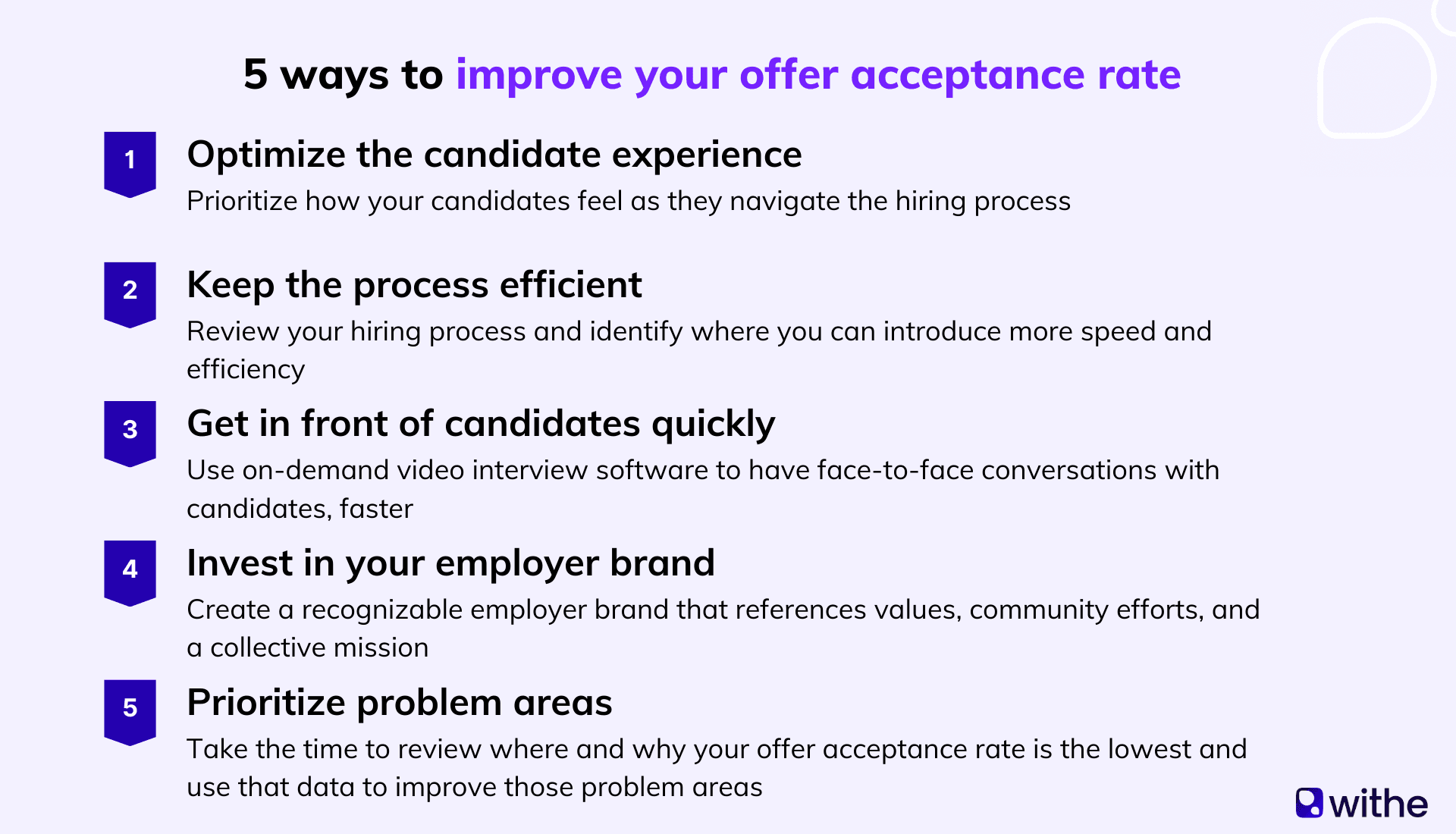Leverage Withe's hiring event platform
Streamline your seasonal and high-volume hiring process and hit your hiring targets.
Across industries, recruitment teams are prioritizing efficiency — and it makes sense. In North America, the last year and a half has been defined by exceptionally low unemployment rates, leaving companies competing for a limited pool of qualified candidates. Add that to the fact that candidates have higher expectations than ever for recruiting processes, and efficiency quickly becomes a differentiator.
In practice, this means many recruiting teams are taking a more performance-driven approach where they measure a variety of metrics and seek to optimize them. One such metric is the offer acceptance rate.
In this piece, we’re exploring what the offer acceptance rate is, how it’s measured, and sharing five best practices that you can use to improve it.
Leverage Withe's hiring event platform
Streamline your seasonal and high-volume hiring process and hit your hiring targets.
What is the offer acceptance rate?
The offer acceptance rate measures the proportion of job offers a company extends that are accepted by candidates. The value is given as a percentage and can be used to understand the acceptance rate across a period of time, for specific job types, or within a given department.
How is the offer acceptance rate calculated?
Measuring your offer acceptance rate is fairly simple. You take the number of accepted job offers, divide it by the number of offers made, and then multiply that number by 100.

So, for example, if your company extended 100 offers last year, and only 80 candidates accepted their offers, then your offer acceptance rate for that year would be 80%.
As part of the calculation, you should also determine the time period you want to measure for. For example, you can compare the offer acceptance rate from quarter to quarter, or from one year to the next to show how your team is progressing. While this measurement is important to do at a company-wide level, there are also opportunities to focus on specific job types or departments to understand which roles are the hardest to hire for and where you should be investing your optimization efforts.
Why is the offer acceptance rate important?
Used with other recruitment metrics, your offer acceptance rate can help showcase what the recruitment team is doing right. For example, a high rate could indicate that your team is doing all the right things in attracting the right candidates and keeping them engaged throughout the hiring process. Having a high offer acceptance rate also reduces costs as you don’t have to spend additional time and resources following up with other candidates or restarting the recruitment process.
In addition, your offer acceptance rate can also highlight potential areas of improvement. For example, a poor offer acceptance rate could show that your job offers aren’t competitive enough, that your employer brand isn’t resonating with potential employees, or that candidates aren’t having an optimal experience. Narrowing in on the issue may require asking your candidates for feedback after they reject your offer.
What is a good offer acceptance rate?
Whether an offer acceptance rate is good or not will vary significantly from one industry to another, as well as from one role type to another. According to Lever’s 2022 Talent Benchmarks Report, companies had an average 81% offer acceptance rate in 2022. That said, high-performing recruiting teams operating in a non-competitive talent market are more likely to see numbers between 90-95%. If your team has an offer acceptance rate that sits more in the 50-75% range, then it might be time to implement some of the strategies outlined below.
5 ways to improve your offer acceptance rate
From improving the candidate experience to having face-to-face conversations early, here are five best practices you can use to grow your offer acceptance rate.
1. Optimize the candidate experience
Take the time to evaluate every part of your hiring process with a candidate experience lens. Is your application form easy to fill out and optimized for mobile? Are you communicating often and transparently with your candidates? Is it easy to schedule an interview? Do candidates have an easily accessible channel for asking questions? These are all things that can contribute to a positive candidate experience and increase the likelihood of a candidate accepting an offer.
2. Keep the process efficient
Once you’ve reviewed your hiring process from a candidate experience perspective, go back and look at it again from an efficiency standpoint. What can you do to help your team move faster? Introducing speed into the equation will not only contribute to keeping your candidates happy, it will also better position you to get an offer out the door faster than your competitors. As an added benefit, focusing on efficiency will also help you improve other key metrics like time to hire and time to fill.
3. Get in front of candidates quickly
Candidates are more likely to accept a job offer if they’ve had a chance to talk to someone at the company and ask questions. This is why real-time interviews are so important, and where asynchronous interviews can negatively impact your efforts. Using on-demand video interview software, recruiters can talk to candidates early on in the hiring process, giving them the opportunity to have a real conversation about the role, the company, and what the future could look like for them. Plus, it also helps accelerate relationship building and trust, both important drivers for offer acceptance.
4. Invest in your employer brand
More and more, candidates want to work at companies that reflect their values and interests, while also being active contributors to their communities. As such, there’s a lot of value in incorporating these elements into your employer brand and communicating them effectively on your careers page, social channels, and more. This gives your candidates an opportunity to learn about your employer brand before they even apply, and it equips your recruiters with consistent messaging that they can incorporate into any conversation.
5. Prioritize your problem areas
As a recruiter, you likely have some teams and departments that are harder to hire for compared to others. If you’re not sure, spend some time calculating the offer acceptance rate per department to determine which teams are lagging. With this data, you can start asking questions as to why a team is underperforming and uncover areas of opportunity for improving the situation. Addressing these problem areas more proactively can contribute to raising the overall offer acceptance rate.

Leading candidates towards a “yes”
Recruiters know that the hiring process is a two-sided process. At the end of the day, it will be up to the candidate to decide whether or not they want to work for a company. However, recruiters can play an important role in leading high-quality candidates to a positive outcome. Whether it’s making procedural changes that improve the overall candidate experience or personalizing the experience as needed for specific candidates, there’s a lot that can be done to improve the offer acceptance rate.
At Withe, we’re helping high-volume recruiters increase their offer acceptance rates with our on-demand video interview software. Learn more about it on our homepage.




